

Spaceworks Gallery Tacoma, June 20 – August 17, 2017 M – F 1-5
950 Pacific Ave. #205
Tacoma, WA 98401
(Entrance on 11th St.)
Third Thursday until 9PM. Multimedia Program August 17
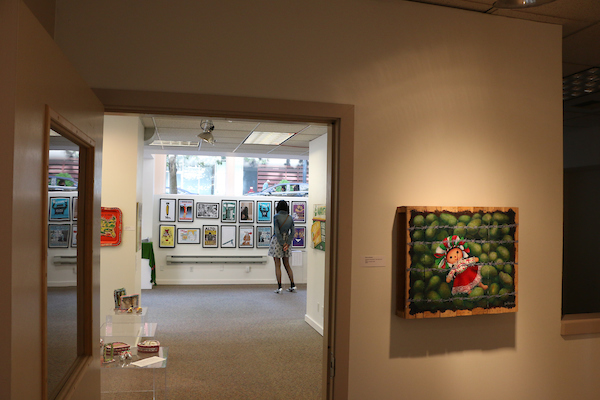
Entrance Shot by Scott Story, Bioluminous, all photos with astericks by Scott Story
INTRODUCTION
Only one mile from this gallery, in the toxic, industrial zone of Tacoma, the Northwest Detention Center, holds hundreds of detainees in a warehouse. Run by the for-profit corporation GEO, the government (that is us) pays more than 100. 00 for each bed occupied each night. The detainees do all the work of the center for $1. per day. They are treated like criminals, but they have committed no crimes. Crossing a border with correct visas is a “malum prohibitum” wrong only because the law prohibits it, not because it is morally wrong. (malum in se). It is a civil offence. People who have crossed borders without papers are escaping violence, and simply seek to support their families in safety. To get legal papers in Mexico or in the US is virtually impossible. The DREAM act first supported by President Bush in 2005 provided the crucial “path to citizenship” but it failed in the Senate in 2010.
But behind these facts and statistics are the personal stories of mothers, fathers, children, aunts, uncles, grandmothers and friends who live in fear every time they wake up in the morning, but resolutely go to work, care for their families, and maintain hope.
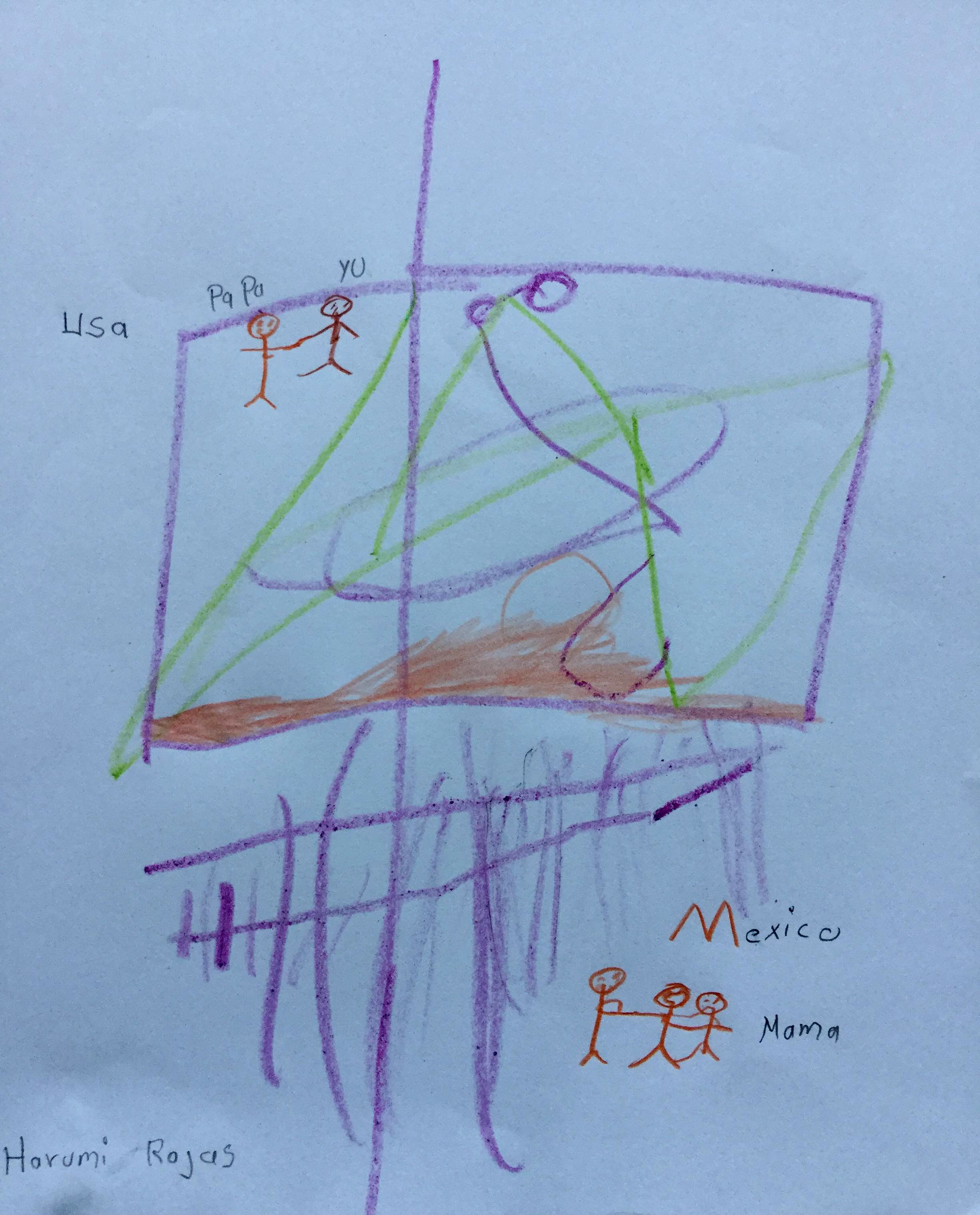
Children’s drawing created in response to question How have immigration laws affected you at a May Day booth organized by Susan Platt and Raul Sanchez
Children live in fear. Youth live constricted lives because they lack social security numbers, drivers’ licenses, even library cards. The Delayed Action for Childhood Arrivals (DACA) has given some of them a way forward, but the program can be cancelled at any moment.
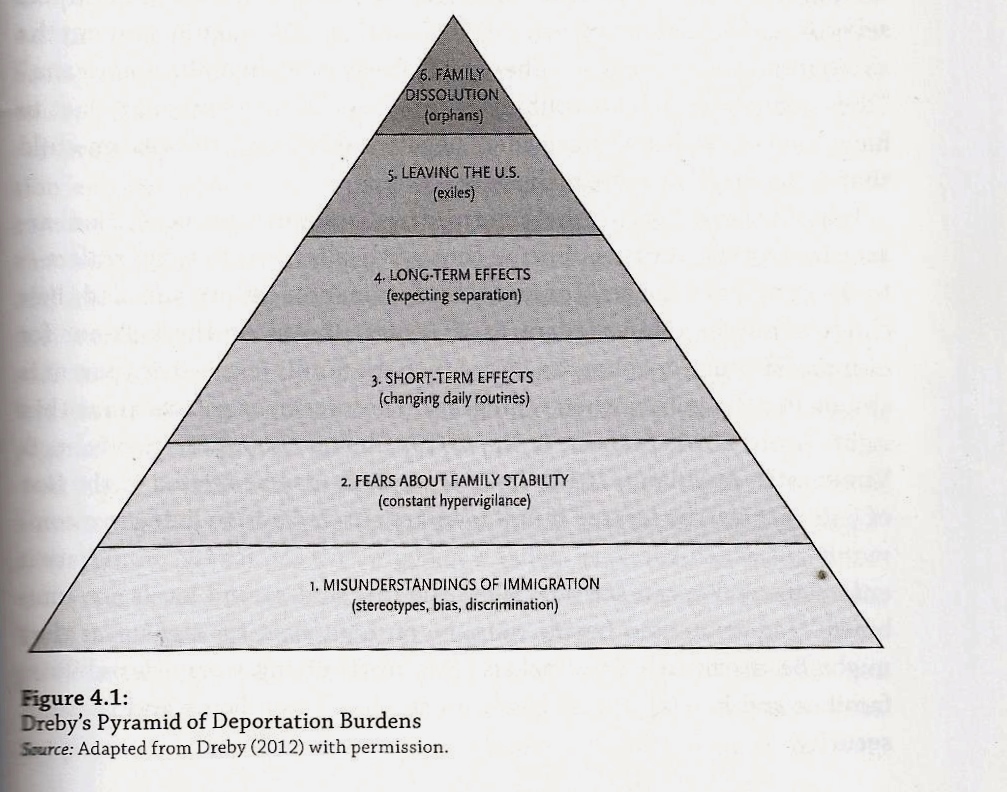
At the same time, the deportation of parents make orphans and exiles of thousands of citizen children every year. Here is a pyramid of anxieties as illustrated in the book by Luis Zayas Forgotten Citizens, Deportation, Children and the Making of American Exiles and Orphans. The illustration is by researcher Joanna Dreby.
Hardworking families saving money from two or three minimum wage jobs lose it all to an unsavory lawyer. Savings for a college education goes to enable a deported father to return to his home and family. The vivid book by Roberto Gonzales Lives in Limbo Undocumented and Coming of Age in America describes these events as he follows children into young adulthood.

Eduardo Trujillo performing his poetry*
But there are also success stories, stories of resistance, of defiance, of courage. These are even less reported in the media, more frequently stories we don’t hear.

Installation*
“Immigration, Hopes Realized, Dreams Derailed” suggests some of those stories of courage, of defiance, of perseverance, of hope and dreams, as well as including the dark side of immigration, most specifically here in Tacoma, at the Northwest Detention Center itself.
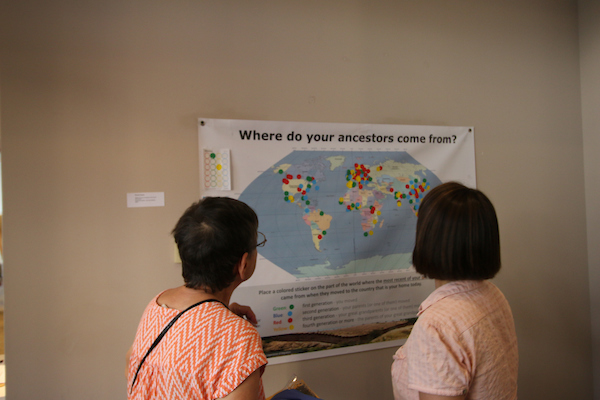
Ricardo Domingez poster at entrance*
The artists, poets, activists, and musicians in this exhibition and programming shed light on our current immigration policies, its damage to individuals and families, its injustice, its corporate roots, its absurdities and the courageous individuals who resist.
We include painting, sculpture, drawing, collage, glass art, film, photography, and video as well as poetry, music and spoken word. The works range from heartfelt to playful, from interactive to informative, from poetic to didactic. The artists, poets and performers include undocumented immigrants, former detainees, current detainees, DACAs, college students, self- taught artists, and professional artists.
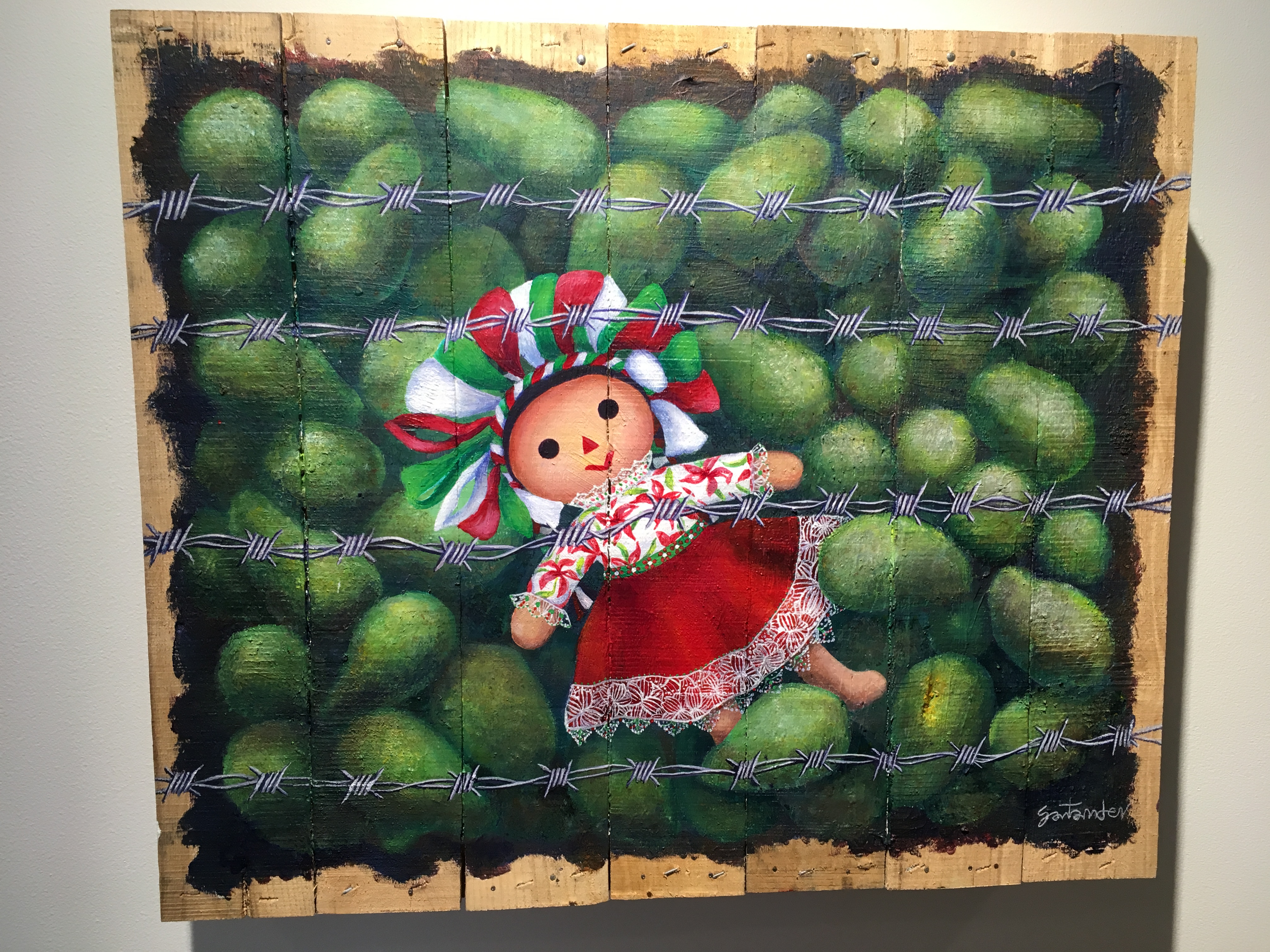
THE ENTRANCE
At the entrance to the gallery, you see a painting by Blanca Santander, Esperanza Abandonada (Abandoned Hope) depicting a doll impaled on the other side of a barbwire fence. Its poignant image of a child who has lost her beloved doll, crossing the line into another place, a child who has left behind childhood, familiar languages and culture, as well as a life close to the land, speaks directly to the hardships of fleeing home to enter an unknown place.

Tatiana Garmendia 3 Joses ( center) and A Green and Peaceful Neighborhood ( left and right) 2017*
In an alcove just to the right is the installation of the work of Tatiana Garmendia. Pale pencil portraits and texts drawn on distressed handkerchiefs honor three generations of men in her family: grandfather, father and son (her brother). We feel the tearing of family as the artist distressed the surface of the handkerchiefs. Her pale writing and drawing on the white background suggests holding onto a disappearing memory. But she brings them to us through her poetic invocations.
The handkerchiefs are framed on both sides by embroidered doilies mounted on drone shots of a suburban neighborhood. On each doily the artist carefully embroidered brief searing references to a nighttime raid based on her own experience in Cuba, but as she states, “it can happen anywhere, anytime. Geographical differences and generational distance between persecuted groups vanish in light of human suffering.”
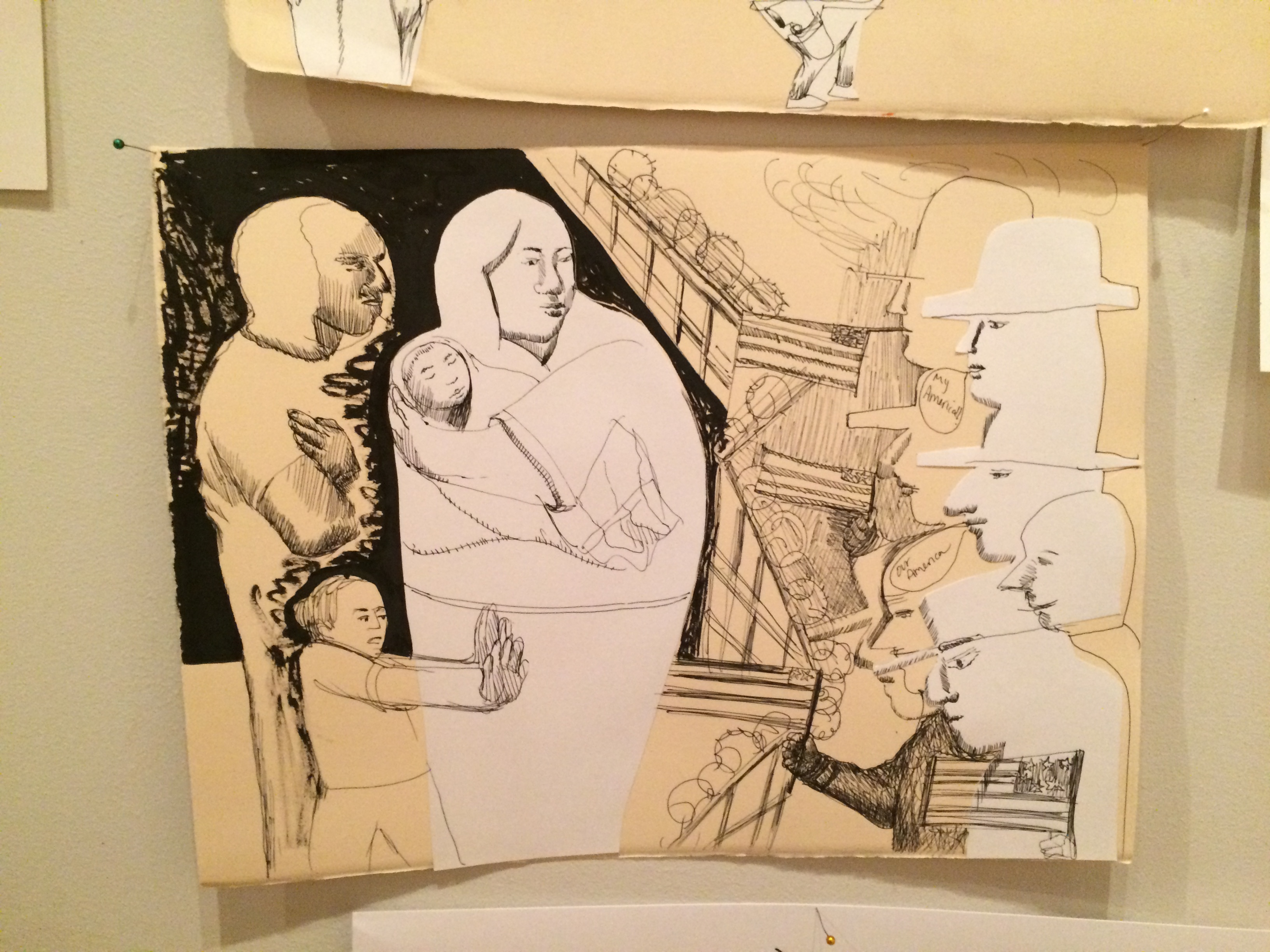
Maria de Los Angeles Undocumented 2016
Indeed, this emotional trauma is echoed in the drawing in the main gallery by
Maria De Los Angeles, “Undocumented,” in which we see a family trying to protect themselves and resist an invasion by ICE officials who spout off nationalist clichés. De Los Angeles, an artist who is undocumented, bravely explores the nightmares of detention raids in her work.
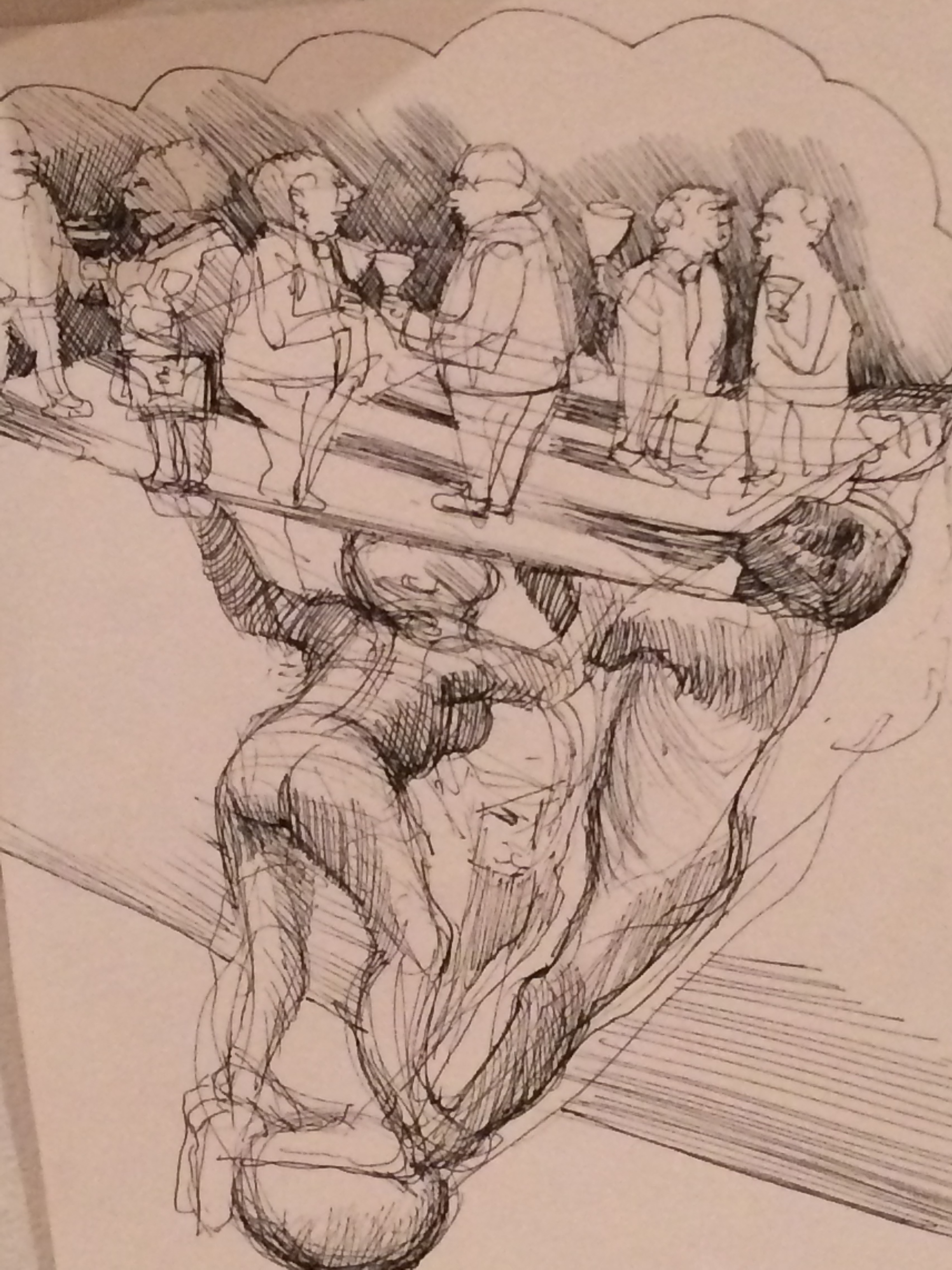
Maria de Los Angeles Holding Everything Up, 2016
She also honors those who work in her small drawing Holding Everything Up: a man and a woman balance on a ball, as they struggle to support a floor that holds up oblivious party goers.
The VIDEOS
The video viewing room includes several videos, two by Tatiana Garmendia.
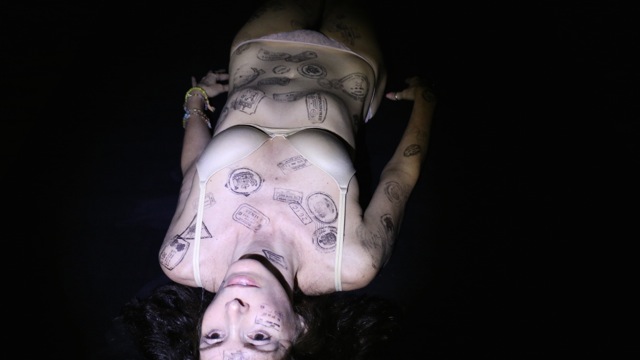
Tatiana Garmendia Still from video Border Crossing
In Border Crossing, 2015, the artist lies almost naked face up, with eyes staring, as we hear a partially coherent series of phrases “the mouth of the border has nothing to say; my border is a mouth; you crossed with nothing to say; why did you cross my home,” and many more variations on these words taken from Reza Mohammad’s poem “You Crossed the Border.” The motionless body is spotlighted from above, as though a surveillance airplane has found her.
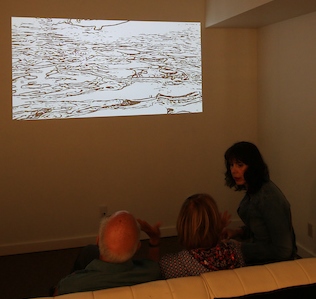
Viewing the Unravelling*
Garmendia’s animation The Unravelling, 2017 functions as both a prose poem and a visual journey that dramatically tells of her father’s arrest and her mother’s grieving.
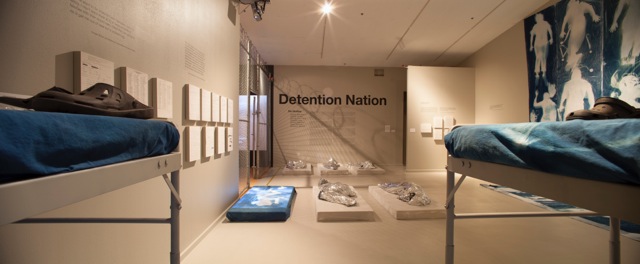
Detention Nation an activist artists’ collective based in Houston, present their installation Sin Huellas (Without a Trace), through the video by Brenda Cruz-Wolf. Sin Huellas recreates the inside of a detention center, with lined up bunk beds and toilets conveying the complete lack of privacy in these facilities. Videos, letters and artwork document the horrifying day-to-day experiences of detainees.
The Wall, by Hide and Seek Productions, is an animation of a grandmother and her grandson fleeing a flaming city, and their struggles to survive and escape a refugee camp next to a wall.
Finally, Think Like a Scientist: Boundaries, gives us the photographer Krista Schlyer who spent the last seven years documenting the environmental effects of the U.S./Mexico border wall, and biologist Jon Beckmann, who studies how man-made barriers influence the movement of wildlife. The video combines animation and film to highlight the huge ecological impacts of a dividing wall on animals that traditionally migrate through this border territory.
INSIDE THE GALLERY
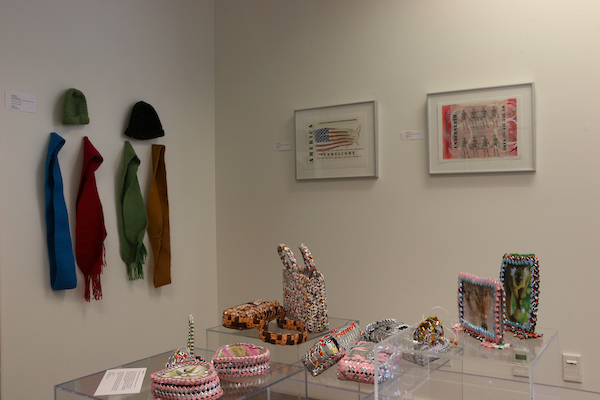
Clarita Malla left, MalPina Chan prints on wall, Pavel Bahmatov central display*
Inside the gallery, we immediately face the stunning work of Pavel Bahmatov, purses, boxes, and other objects, created when he was detained in the Northwest Detention Center(NWDC). Using ramen wrappers and dental floss, Bahmatov weaves together objects of great beauty. He speaks of alleviating the immense boredom of detention by making these objects. Bahmatov was abruptly moved to the Dalles in Oregon this spring. He is currently at a County Jail, an even worse environment that the Northwest Detention Center.
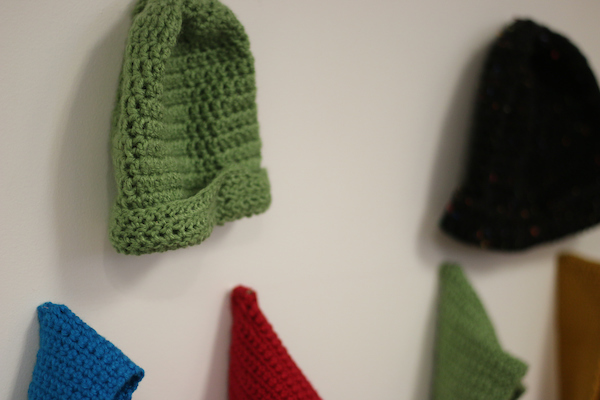
Detail of hats by Clarita Malla*
Currently in the NWDC Filipina Clarita Malla creates woven scarves and hats as her ongoing separation from her family and her grandchildren endlessly stretches from one hearing to the next, from one month to the next.

MalPina Chan A Nation of Immigrants in Pursuit of Happiness, 2017(left) and Underneath it all, we are all the same, 2017 (right
MalPina Chan, in her subtle layered works, speaks of the hypocrisy of our policies compared to our rhetoric, as well as pointing out that “we are all the same” in a dramatic count of the bones, organs, and amount of water in every human.
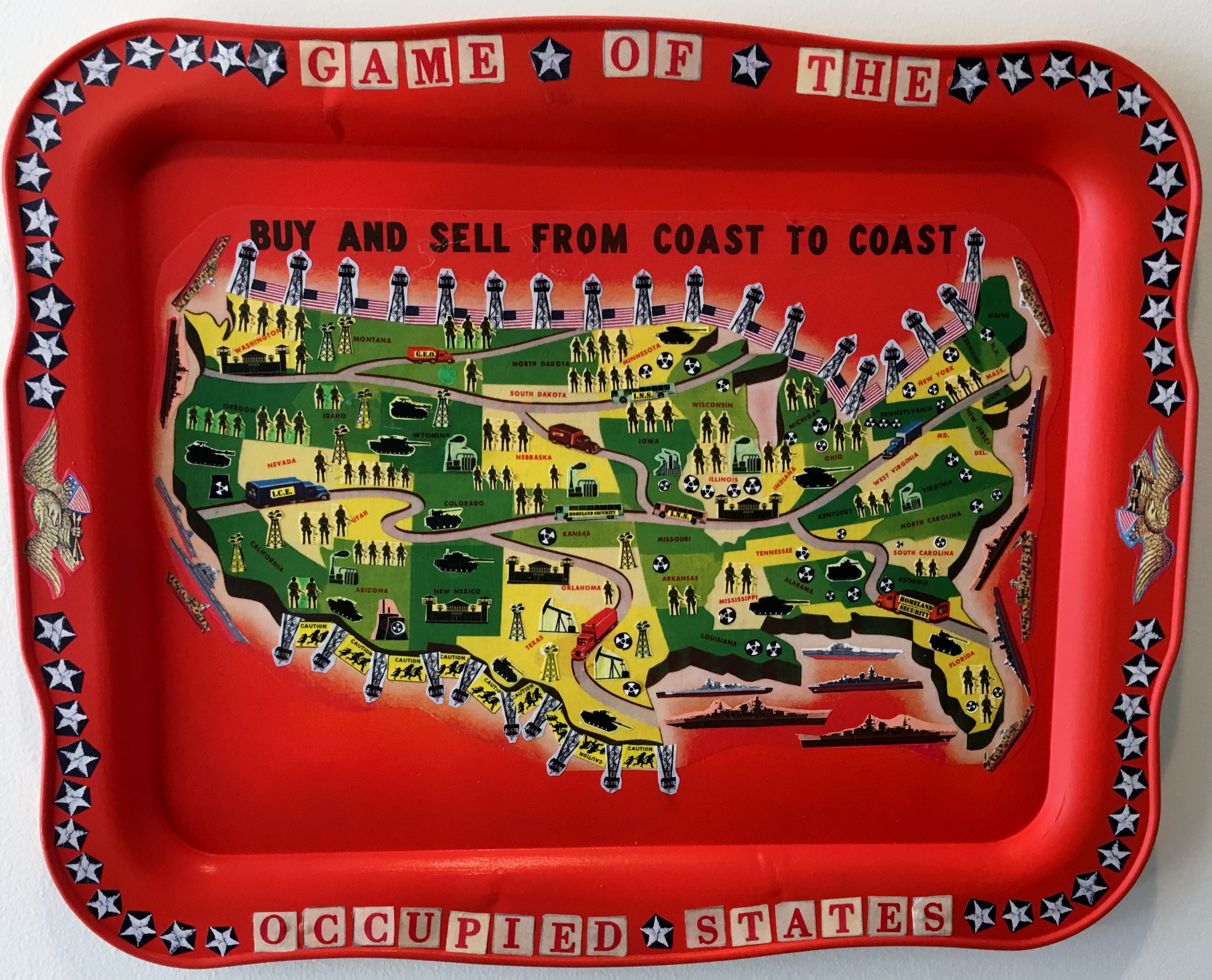
Deborah Faye Lawrence Game of the Occupied States
Deborah Faye Lawrence’s intense bright red “tv dinner tray” collage Game of the Occupied States, (“Buy and Sell from Coast to Coast”) provides a chilling image of a police state with surveillance towers punctuating a border fence around the whole country. Criss-crossing the country are tanks, soldiers, and transports run by prison companies.
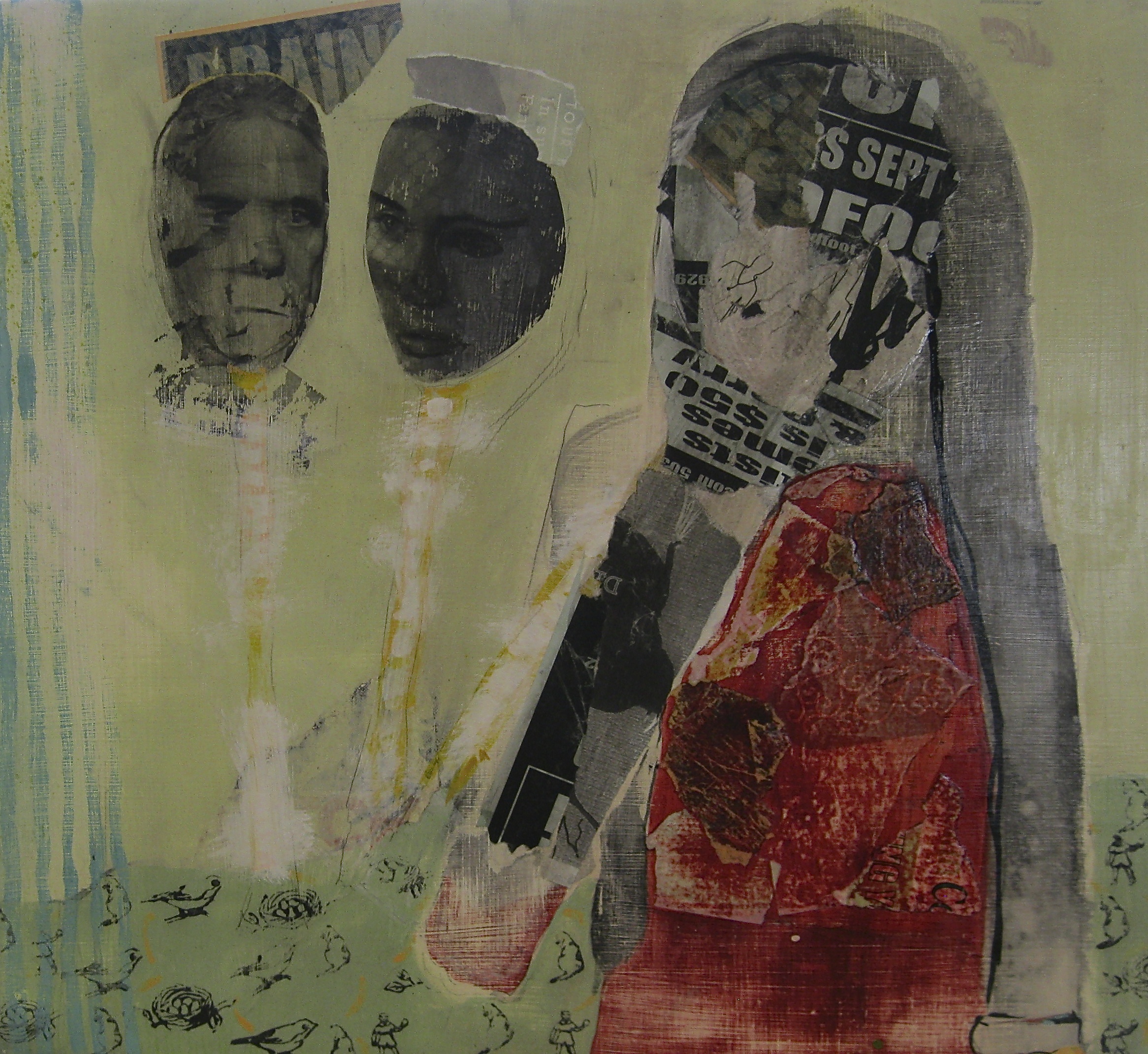
Janice LaVerne Baker, Immigration, 2014
Janice La Verne Baker quietly conveys the anxiety of confrontation with immigration officials,
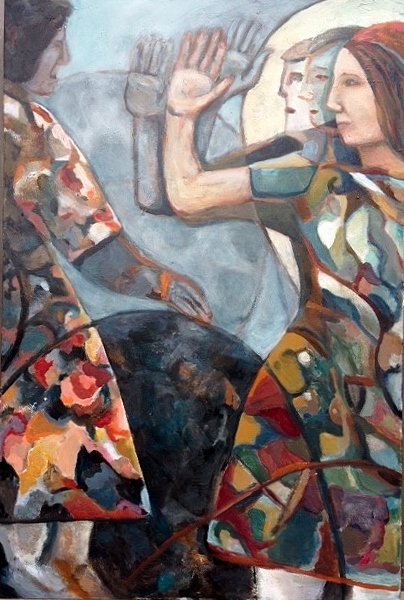
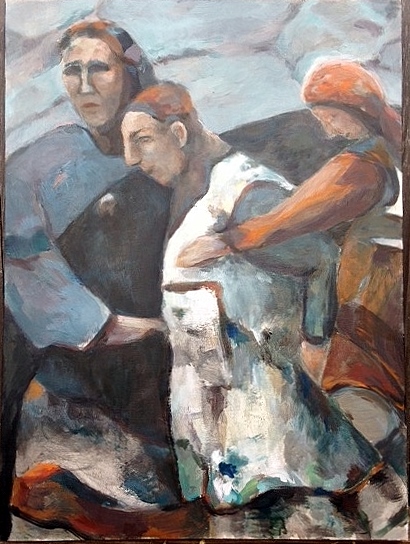
while Arni Adler speaks to the same subject in Ushering In ( above right) and the Welcoming,( above right) painted in direct response to outpouring of protest to the “muslim ban” that the current administration attempted to introduce in January.
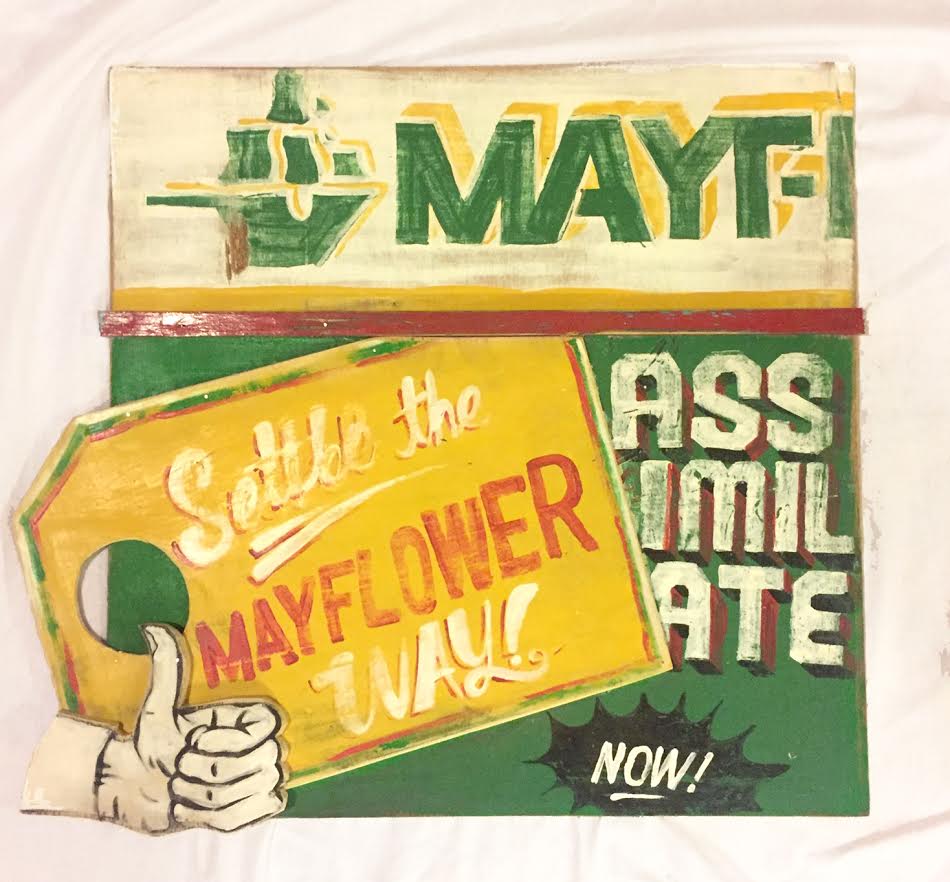
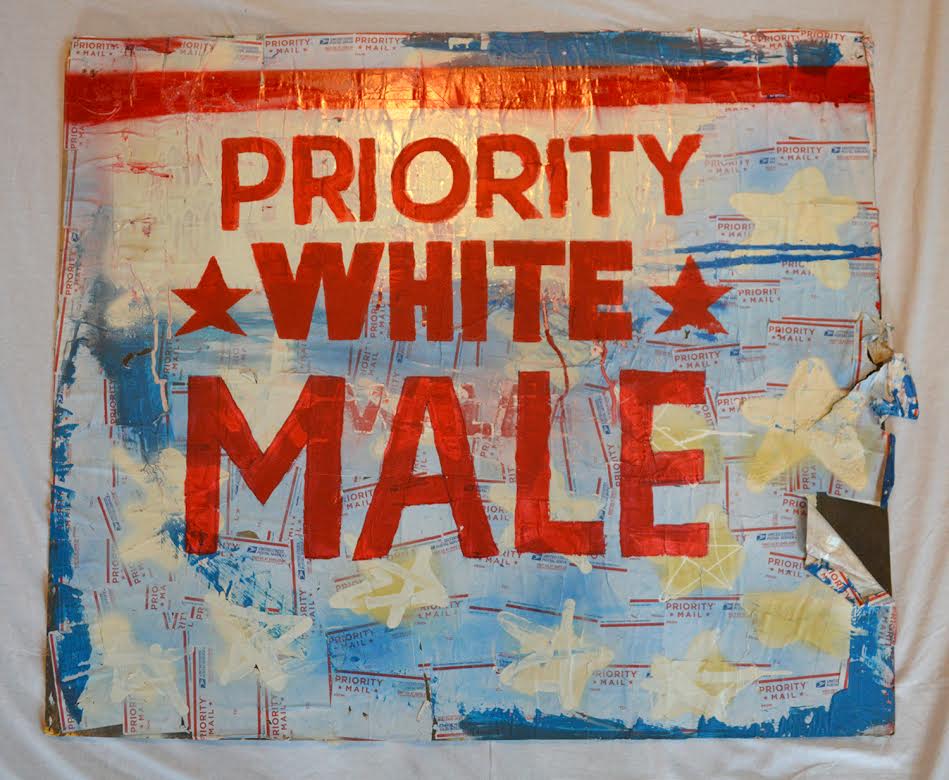
Devin Reynolds’ bold paintings provide an historical as well as a humorous reference to the unavoidable fact that racism underlies the entire subject of immigration, from the first white settlers to the present day.
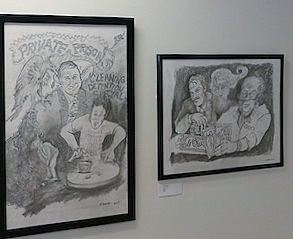
Pam Orazem*
Pam Orazem amusingly caricatures the power games of the manipulators of immigration policy.
Andrea Eaton’s silkscreen print Guadalupe Garcia,
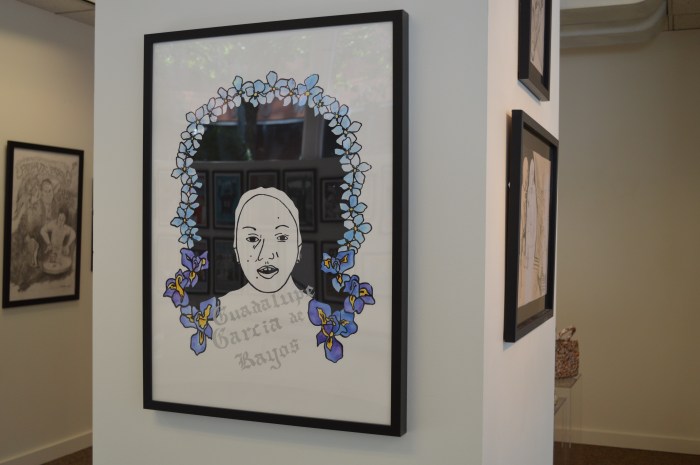
and
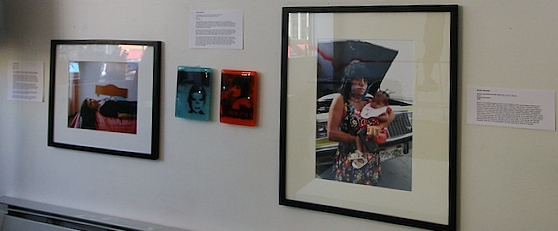
Marilyn Montufar*
Marilyn Montufar’s photograph Dani (one of a series following Dani’s life) both refer to women who face the challenges of deportation. Montufar’s small portraits on glass pay homage to two of the many women who have lost their lives in Juarez, Mexico as they attempted to make a living at the maquiladora factories on the border.
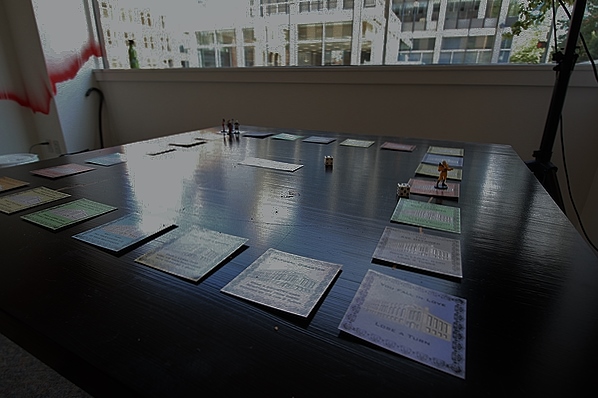
Christian French INS Game*
Christian French invites us to play a board game. He suggests the constant back and forth of the Naturalization process, with one step forward, and two steps back. The original of this work is embedded in the floor of the old INS (Immigation and Naturalization Service) building in Seattle, that has been transformed into artists’ studios. The fact that that center included Naturalization whereas the Northwest Detention Center serves, with only a few lucky exceptions, as a way station to deportation, tellingly exposes the shift in our policies to increasingly draconian approaches.

David Long painting mural*
David Long’s
mural partners
with our video “Sin Huellas” (without a trace). He gives us the words of the Hunger Strikers demands at 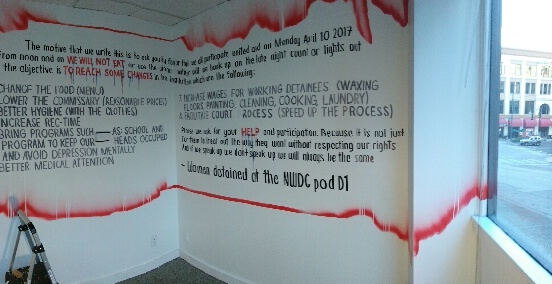 the NWDC. We see the terrible conditions the detainees are subjected to when we read this letter. None of their demands have been met.
the NWDC. We see the terrible conditions the detainees are subjected to when we read this letter. None of their demands have been met.
Nearby the writings and drawings by children created in a May Day project with Raul Sanchez and myself in 2016, speak loudly to the trauma of immigration policy as it strikes the young. ( see top of post for an example)
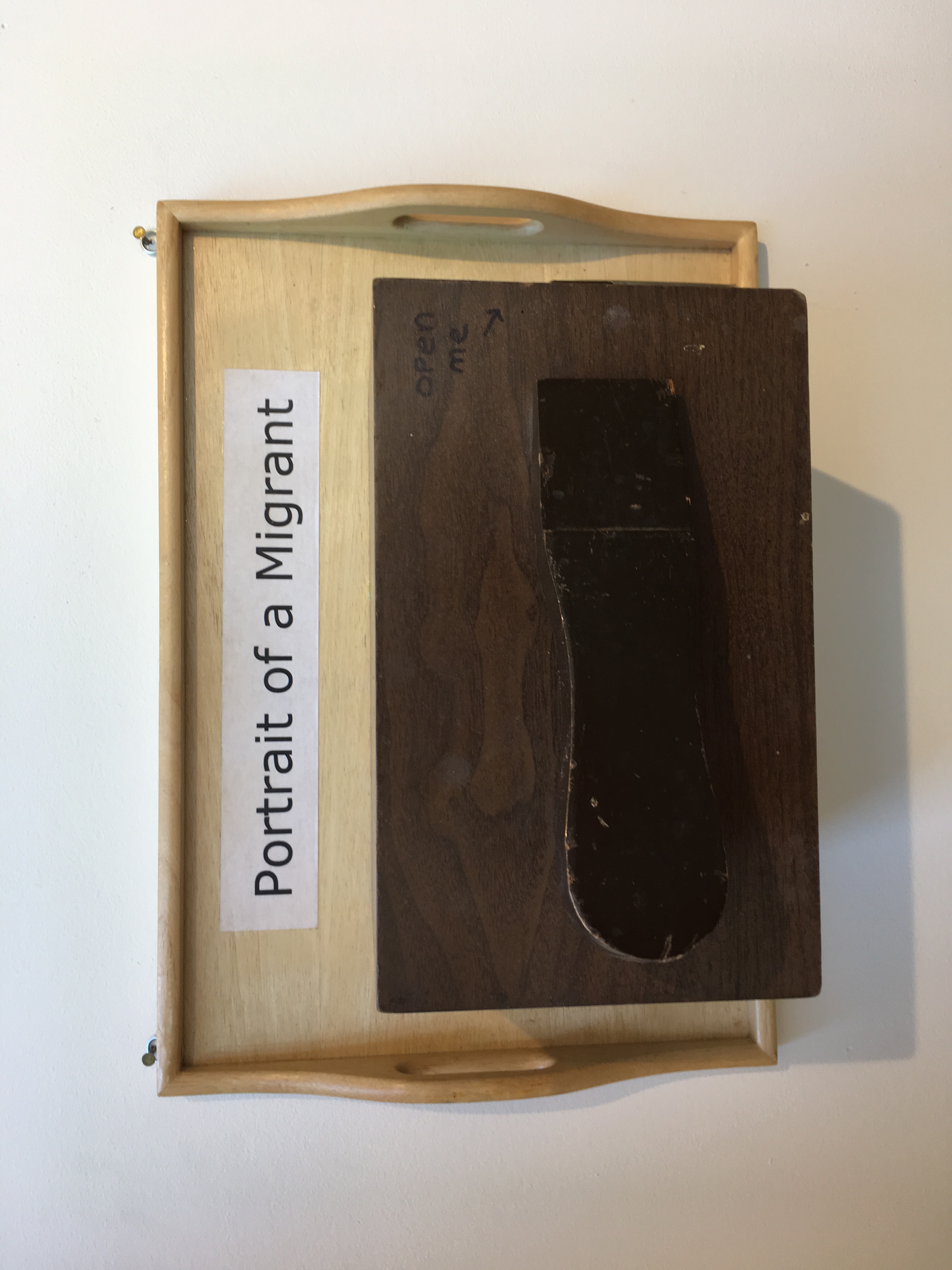
Ricardo Gomez created a group of sculptures from found shoe shine boxes. As we open each box, called Portrait of a Migrant, we see our face reflected back from a mirror inside. We all migrate, he says, we all move from one place to another, adjust to new cultural contexts.
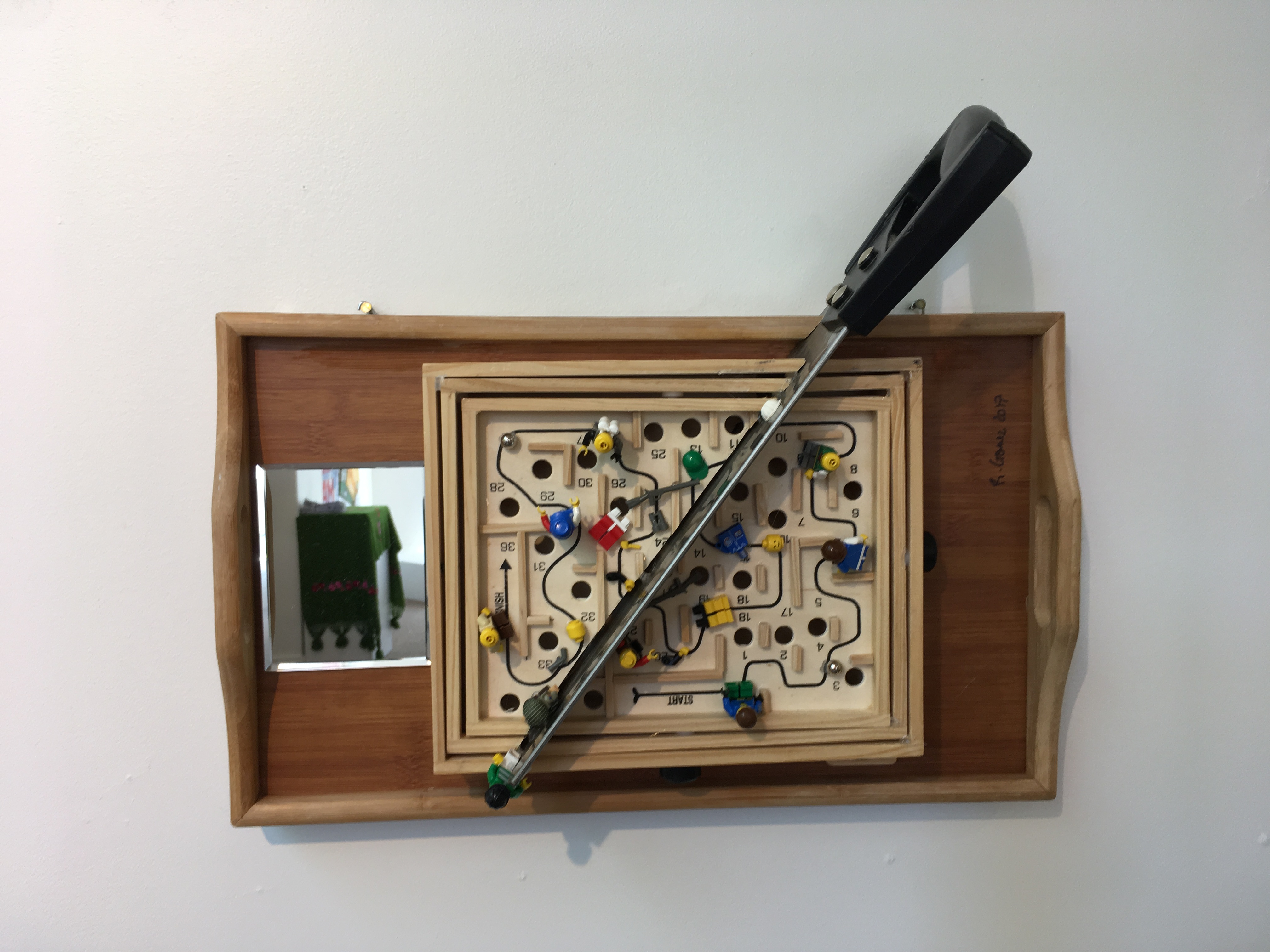
In Two Sides of the Wall, he simply placed a saw diagonally across a labyrinth game, with workers made from Lego pieces on each side.
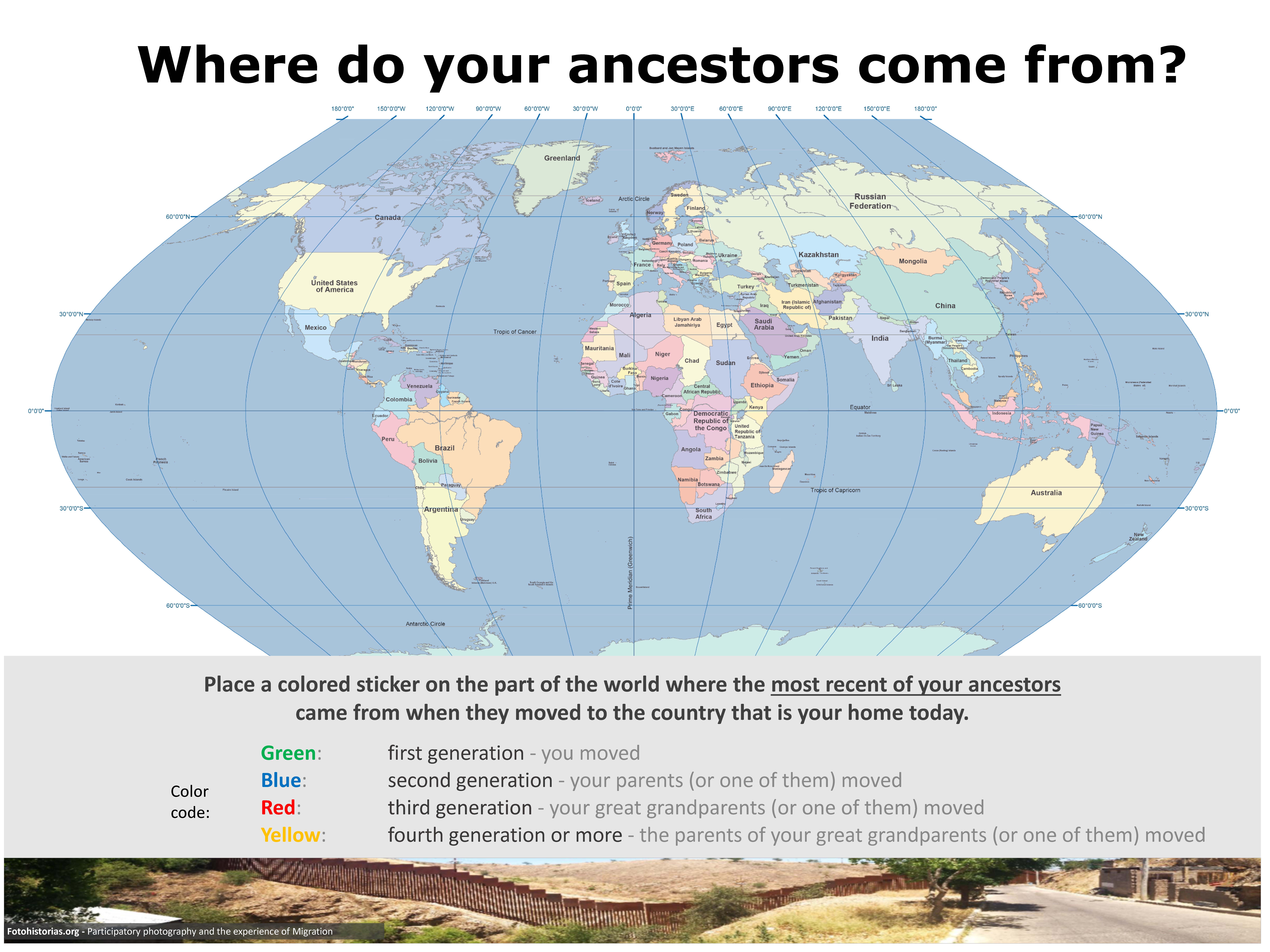
The interactive poster, Where do your ancestors come from? Invites us to add our own information going back four generations.

Last, Gomez in collaboration with Angie Tamayo assembled the Mi-gra-tion book in a flip flap format, here embroidered by a Woman’s Collective in Oaxaca. Migrants tell their stories. As we “flip-flap” through the three part texts and photos, we hear shared experiences in many voices.
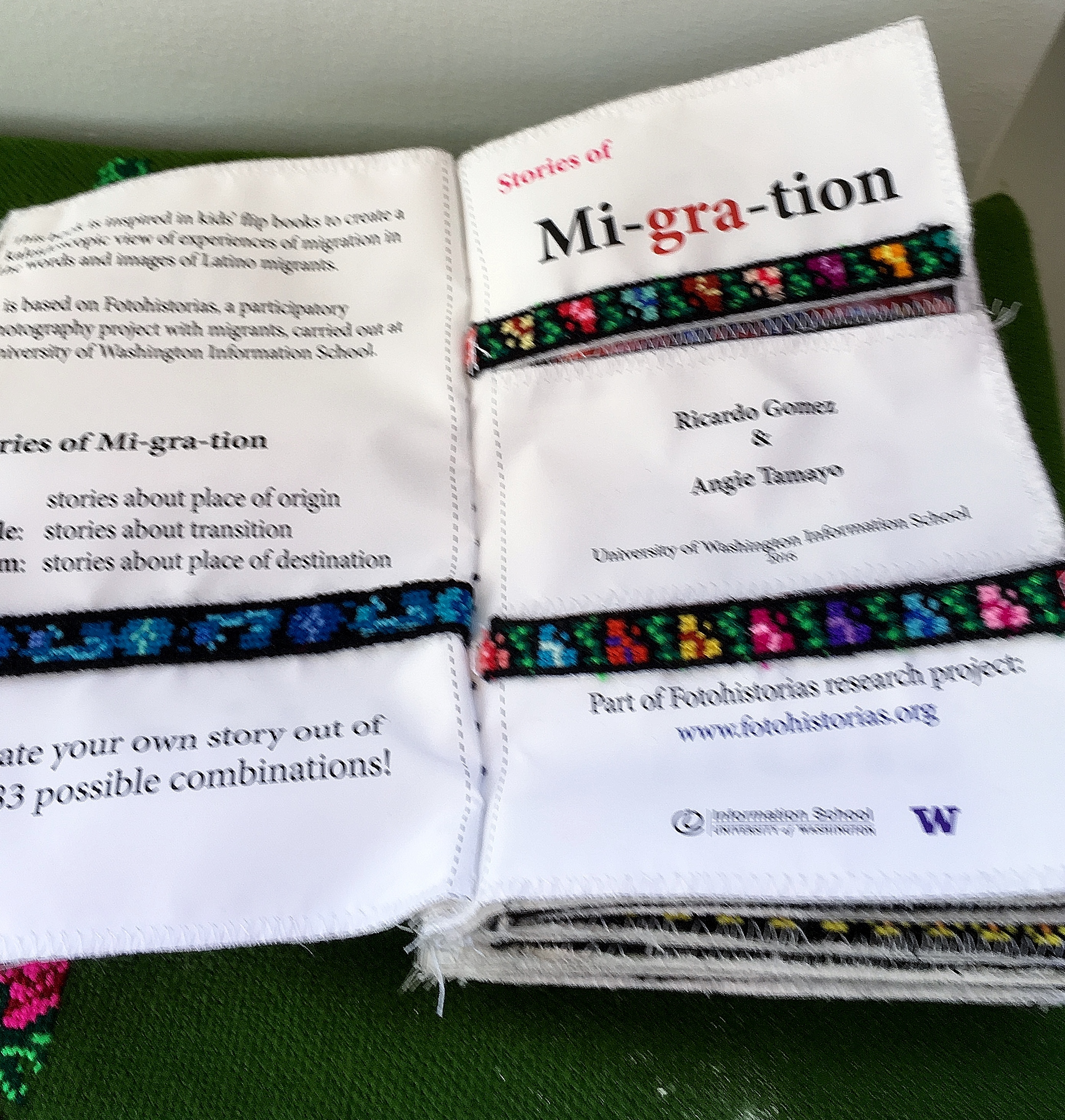
There are two groups of work in the exhibition First there are selections from the 2012 Migration Now portfolio (organized by Justseeds/CultureStrike).
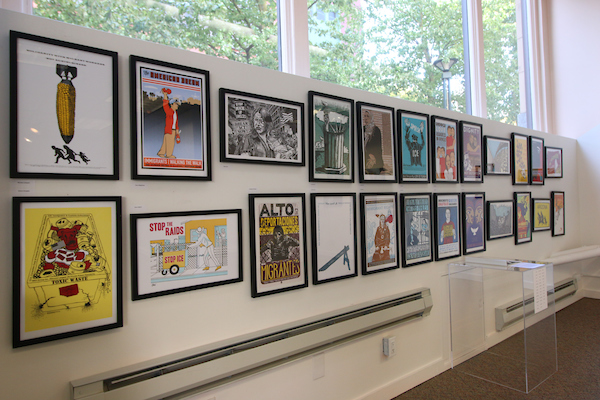
Installation Migration Now*

Viewing Migration Now*
The Migration Now portfolio created by nationally known artists includes reference to many aspects of the immigration crisis, including corporations profiting from the detention centers and the devastating impact of immigration policies on indigenous peoples, families, children, LGBTQ, and Muslims. Some confront the environmental catastrophe of the wall, reinforcing our video Think Like a Scientist: Boundaries
Migration Now Portfolio artists, sponsored by Justseeds /CultureStrike: Lalo Alcaraz, Santiago Armengod, Felipe Baeza, Jesus Barraza Melanie Cervantes, Raoul Deal, Emory Douglas, Molly Fair, Art Hazelwood Ray Hernandez, Nicolas Lampert, Josh Mac Phee, Dylan Miner, Oscar Magallanes, Colin Matthis, Fernando Martí, Oree Originol, Favianna Rodriguez, Roger Peet, Shaun Pete Yahnke Railand, Julio Salgado, Silfer and Janay Brun, Meredith Stern, Mary Tremonte, Erik Ruin, Kristine Virsis, Ernesto Yerena
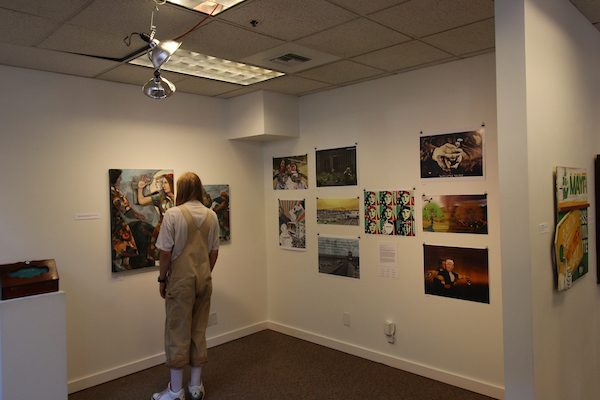
Viewing Arni Adler and student portfolio
Second there is the group of posters by Beverly Naidus’ students from the class “Art & Global Justice,” at the University of Washington, Tacoma. Here is a selection of them
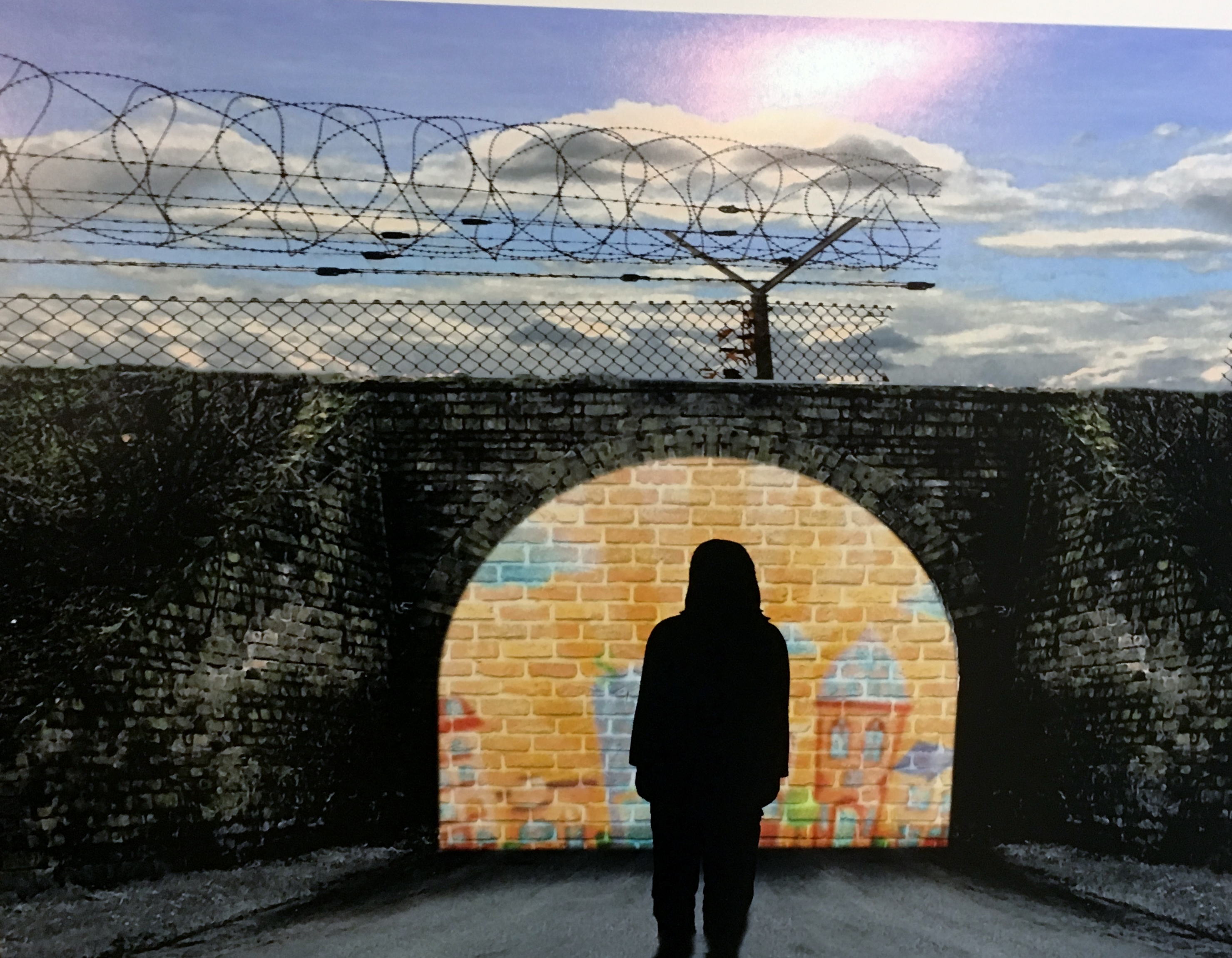
Cassandra Green My Dream was an Illusion

Josephine Green Fenced In
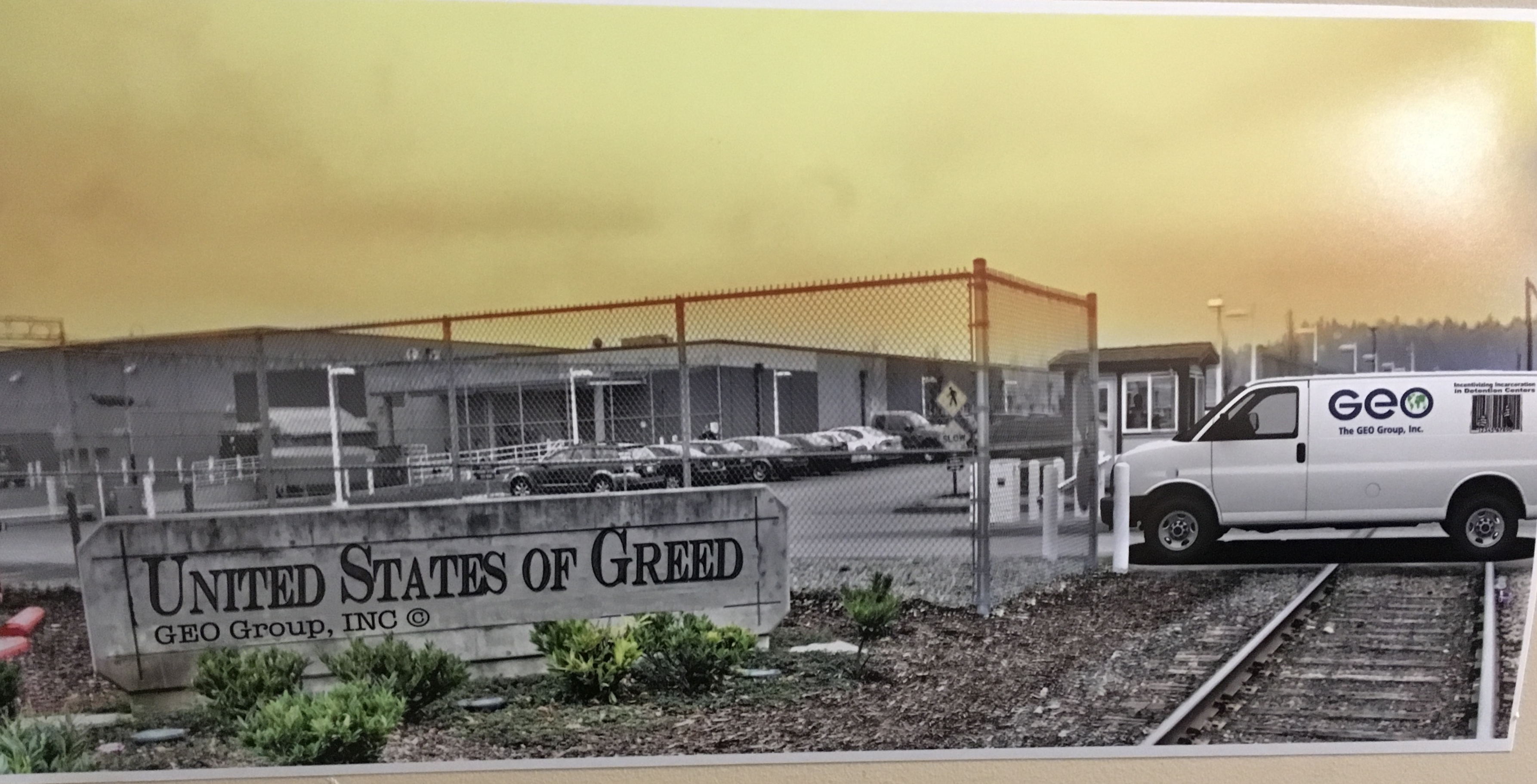
Leni Reinwald
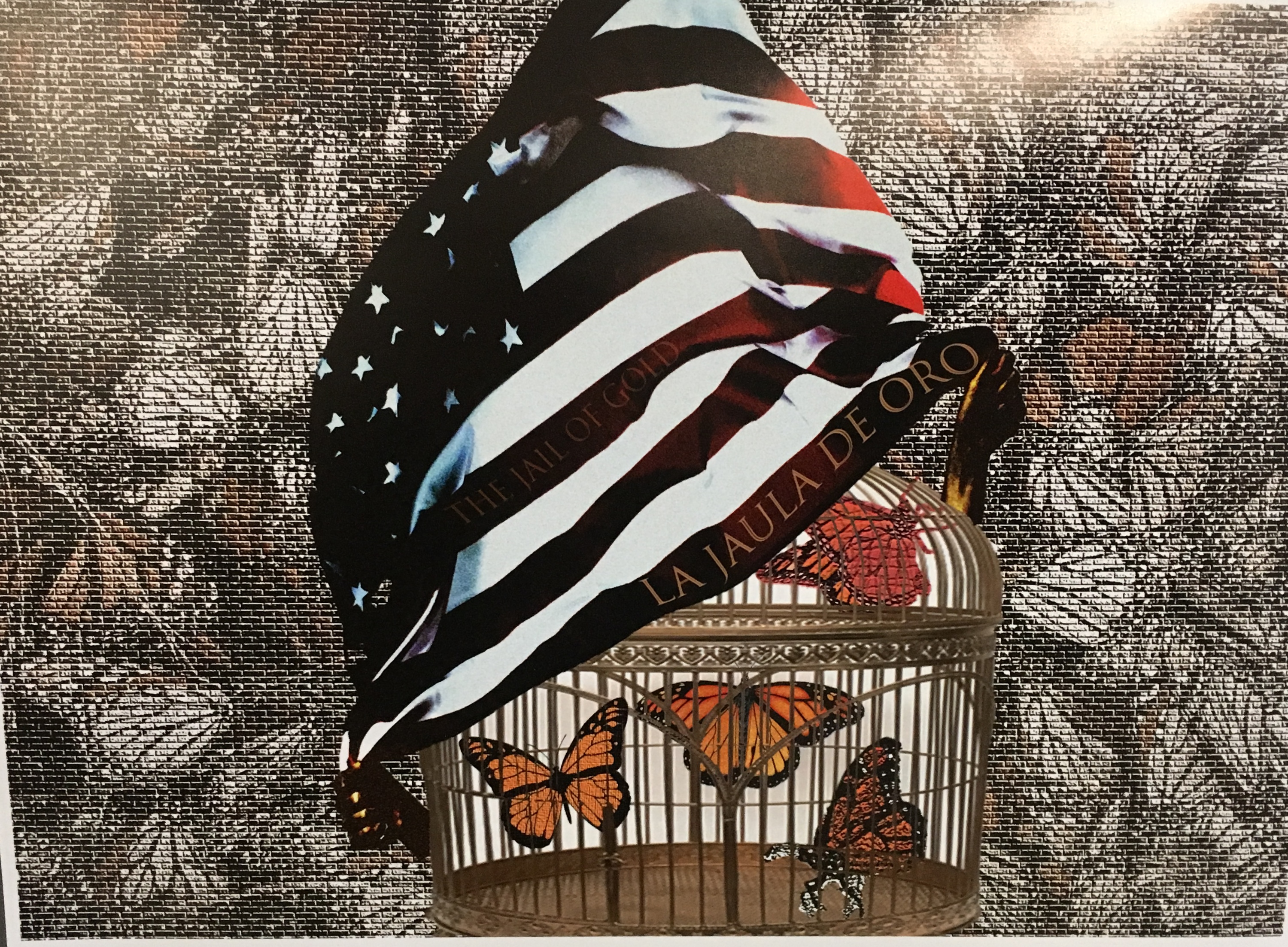
Karla Gonzalez La Jaula D’Oro
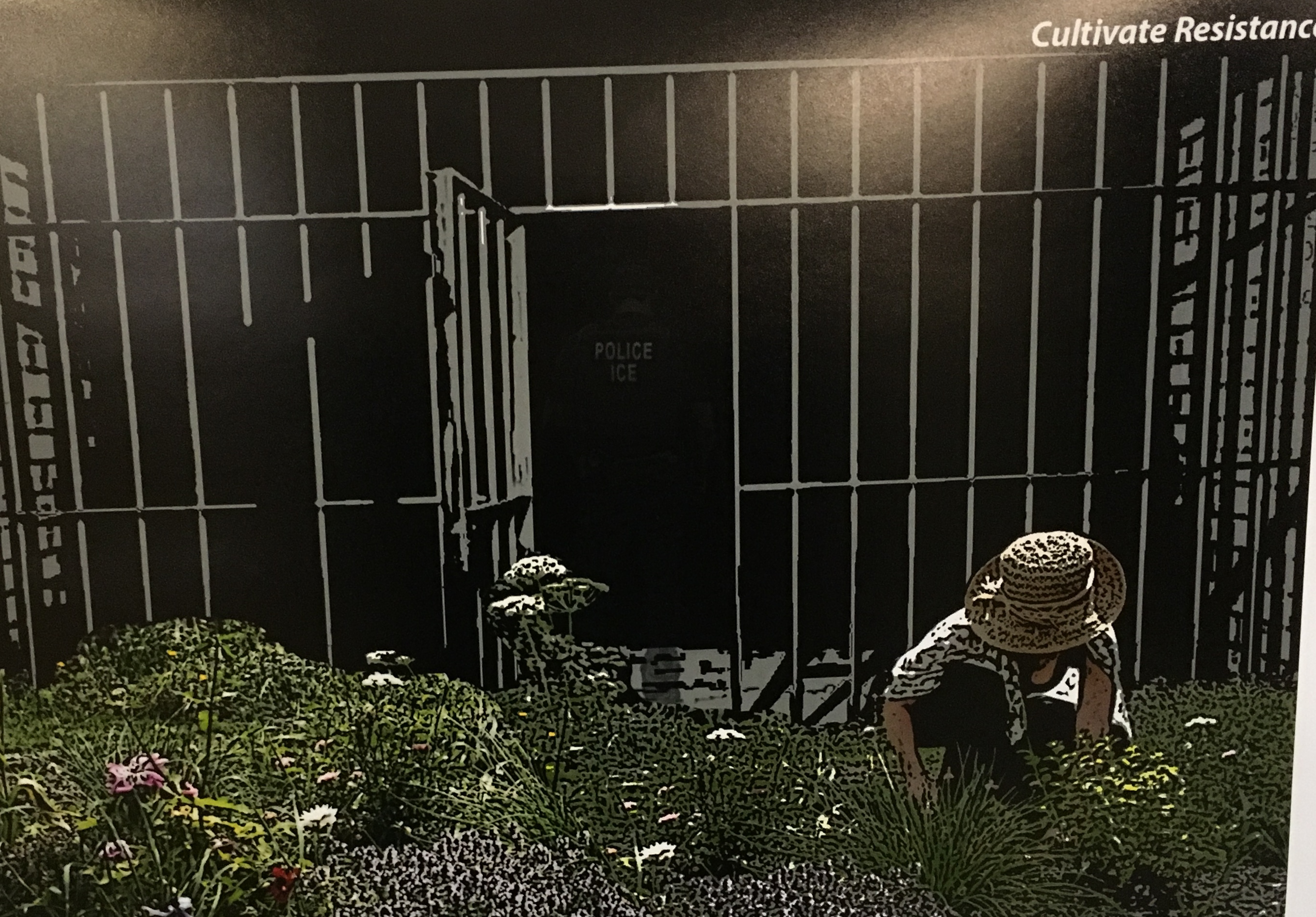
Krystal Hedrick Practice Resistance
Art and Global Justice Project artists, taught by Beverly Naidus, artist/writer/activist and associate professor of interdisciplinary arts, UW Tacoma: Diana Algomeda, Fazeema Bano, George Camacho, Emily Clouse, DA James Christian Flores, Karla Gonzalez, Cassandra Green, Josephine Green, Ryan Hanley, Krystal Hedrick, Natalie Lawrence, Wesley Scott, Carolyn Reed, Levi Reinwald
POETS MUSICIANS ACTIVISTS
July 20
Smokey Wonder, hip-hop free form DJ, Mr. Wonder seeks to unify today’s music with that of the past, creating interesting and unique sonic compositions glo’d up with scratches, beat juggling, mixing, and blending techniques to rock the party.
Ricardo Gomez, Associate Professor at the University of Washington Information School, and faculty affiliate with the Latin American & Caribbean Studies Program and the UW Center for Human Rights. He specializes in social dimensions of the use (or non-use) of communication technologies, especially in community development settings. He will be presenting selections from migration stories included in Fotohistorias, and Mi-gra-tion.
Eduardo Trujillo, passionate refugee who seeks for a way to bring peace of mind to those incarcerated and or in fear of deportation. Eduardo brings hope to people through music and spoken word.
David Garcia, artist from Walla Walla, writes multicultural poetry to express his ideas and to give hope to people.
Raúl Sanchez, bilingual poet, an interpreter, translator, a 2014 Jack Straw Fellow, Poetry on Buses judge, a TEDx participant, human rights advocate and a mentor for the PONGO program in the Seattle Juvenile Detention Center
Maiah Alicia Merino, Mexican-American Indigena writer, writes poetry, prose, short stories and plays. Maiah weaves culture, language, present and past to bring vibrant characters to life–speaking life into the shape of the stories.
Marcus Berley, poet, has written a dozen volumes of poetry, mostly in the short, simple style developed over the centuries in China and Japan. For the past 5+ years he has worked professionally as a psychotherapist, primarily with children and adolescents.
Anna Bálint, poet, is the author of Horse Thief, a collection of short fiction spanning cultures and continents and two earlier books of poetry. She recently edited Words from the Café, an anthology of writing from people in recovery.
Here is Scott Story’s vimeo about the performance evening.
August 17
Tello and the Invisibles. The new song or La Nueva Cancion, of Latin America is a musical movement that has its roots in folk music and expresses the concerns, hopes and struggles of the people. It is music with a social message. Not necessarily protest music, but music that speaks of love, hope, justice and equality. La Nueva Cancion is the voice of human rights. It is music by the people for the people.
Maru Mora Villalpando, Bellingham, Wa, Bellingham, Wa, is community organizer, founder of Latino Advocacy, member of the National Campaign Not One More Deportation and co-founder of NWDC Resistance
Gabriella Gutiérrez y Muhs, Ph.D. is the author of several collections of poetry, including the recently released The Runaway Poems, addressing the epidemic of runaway youth. The daughter of immigrant farmworkers from Durango Mexico, Gabriella Gutiérrez y Muhs has represented the United States abroad as a Chicana poet, in several countries.
Marcos Martinez is Executive Director of Casa Latina, a worker center in Seattle, WA. Casa Latina serves immigrant Latinx day laborers and domestic workers through employment, education and community organizing. Marcos formerly served as Executive Director of Entre Hermanos, a nonprofit Latino LGBTQ community. Before moving to Seattle, Marcos spent 20 years working at community radio KUNM in Albuquerque, NM.
Rocio Lopez, daughter of Angelica Guillen, is reading poetry by her mother. Angelica Guillen, Professor of Composition and Literature, Skagit Valley College: 1992-2010. Cesar Chavez Human and Civil Rights Award in 2010. Her heartfelt poetry comes from her life experiences as a campesina for 18 years, working in Skagit Valley fields while living in a migrant labor camp outside LaConner, WA and her lifelong experience as a Latina woman.
